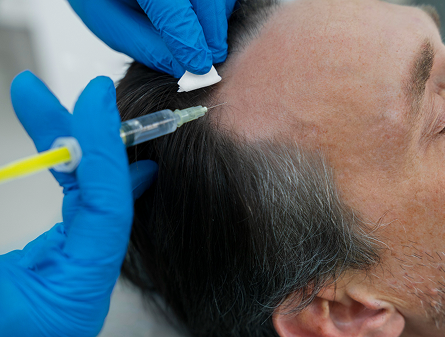Pulsed Electromagnetic Field (PEMF) therapy utilises low-frequency electromagnetic fields to promote healing in tissues. It can prolong the growth phase of the hair growth cycle in order to inhibit hair shedding.
Microneedling involves creating tiny punctures in the epidermis (top layer of the skin) with very small needles. By doing this, the skin’s natural healing properties are stimulated and hair growth can be promoted from dormant follicles.
Microneedling is a minimally invasive treatment that can be performed at home or in a clinic. PEMF therapy is not invasive and there are no reported side effects but is less widely available. Explore the comparison table below to see which treatment works best for you.
- PEMF uses pulsed electromagnetic fields to energise scalp tissue and promote healing.
- It stimulates the blood flow and encourages follicular activity without physical invasion.
- Ideal for initial hair loss.
- Painless, non-surgical, and can be used at home.
- Needs regular use for best results.
- Microneedling involves using small needles to cause micro-injuries on the scalp, which stimulate the healing process and collagen formation.
- Typically performed monthly or weekly.
- It can be done at home or in clinics.
- Often used in combination with topicals.
- Involves some mild discomfort or redness post-treatment.
- PEMF devices can be costly upfront, but are reusable, making them cost-effective over time.
- The initial investment is higher with home use than with micro needling, but it may be lower in the long term.
- Microneedling devices are generally affordable, though clinic treatments cost more per session.
- Unlike PEMF, it may involve ongoing professional fees if not self-administered.
- PEMF is applied every day or several times a week for 15–30 minutes, depending on equipment settings.
- It is painless in contrast to microneedling and does not require recovery time.
- Microneedling is less frequently done, but with each session, there can be downtime due to redness or tenderness of the scalp.
- Unlike PEMF, treatments may need spacing to allow healing.
- PEMF emits low-frequency electromagnetic waves to energise scalp cells and improve follicle health.
- Unlike microneedling, it does not disrupt the surface or break the skin.
- Microneedling involves piercing the scalp with very thin needles to promote growth factors and healing.
- Unlike PEMF, it is a mechanical intervention that exerts its effect by controlled physical stimulation.
- PEMF is exceptionally safe with no pain or significant side effects.
- PEMF is suitable for people with sensitive skin or scalp disorders.
- Microneedling is mostly safe but may possibly cause irritation, redness, or infection if performed inappropriately.
- It requires rigorous post-care and hygiene procedures, unlike PEMF.
- PEMF is easily incorporated into a routine using wearable or handheld devices.
- Compared to microneedling, it requires less preparation and no recovery.
- Microneedling requires concentration and care at home, with sessions taking longer, including setup and sanitation.
- In contrast to PEMF, post-treatment healing adds to the time commitment.
- PEMF devices are available online or through specialist providers but may not be widely stocked in Australian retail outlets.
- In contrast to microneedling, they’re less common in hair treatment clinics.
- Microneedling tools are easily found in pharmacies and online.
- Unlike PEMF, many dermatologists and cosmetic clinics offer in-person microneedling sessions for hair loss.
- PEMF supports long-term follicle health with ongoing use, but results taper off if stopped.
- PEMF offers gradual improvement with no cumulative damage, unlike microneedling.
- Microneedling can offer sustained benefits after a series of sessions.
- Unlike PEMF, it may not require as frequent maintenance once an initial course is complete.
- PEMF is used to supplement oral or local treatment and can be used after microneedling to help with healing and circulation.
- It’s more versatile in potential combinations than microneedling.
- Microneedling enhances topicals like minoxidil or PRP uptake.
- It’s contrasted with PEMF, typically combined with active solutions to achieve maximum penetration and stimulation of the follicles.
- PEMF appeals to users seeking gentle, tech-driven treatment without needles or irritation.
- Unlike microneedling, it offers peace of mind for those sensitive to discomfort.
- Microneedling attracts users seeking active, clinical-style interventions with noticeable effects.
- Unlike PEMF, its hands-on nature may provide more apparent results in the short term.
- PEMF enhances circulation, reduces inflammation, and stimulates cell metabolism to help repair follicles.
- It works without physical trauma or tissue damage relative to microneedling.
- Microneedling boosts collagen and growth factor release and can reverse follicular miniaturisation.
- Unlike PEMF, it relies on controlled damage to trigger biological responses.
- PEMF generates little waste once purchased and operates electrically.
- Unlike microneedling, it is cleaner and avoids the disposal of consumables.
- Microneedling tools may require replacement heads or full devices over time.
- Unlike PEMF, it involves some packaging waste and single-use hygiene products in clinic settings.
Shop our hair solutions
We are committed to providing affordable hair regeneration services for people all over Australia. Our formula can help you regain your confidence.
Shop Now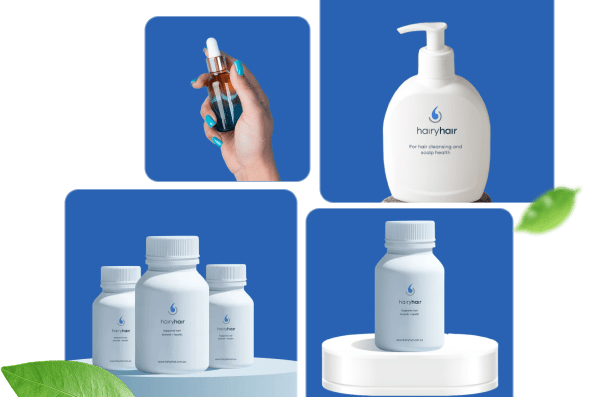

PEMF vs Microneedling Hair Regrowth Effectiveness Comparison Summary
PEMF therapy can be performed at home or in a clinic but sessions or an at-home device are more expensive compared to microneedling. PEMF therapy can be effective as a monotherapy but studies have not confirmed if using microneedling treatment alone can generate results. PEMF treatments are considered to be safe with no reported side effects.
There can be some minor side effects with microneedling including redness, mild swelling, and flaking. When performed at home it is possible to spread infection if your device is not properly sanitised before and after use. PEMF at-home devices, although more expensive, since there is less competition the quality is of a high standard.
Microneedling devices are widely available at a large price range so it’s important not to purchase a cheap device and risk their safety. PEMF is often combined with other clinical-grade treatments such as low-level laser therapy (LLLT) while microneedling is often combined with a topical treatment like minoxidil making it suitable to perform at home as part of your daily routine.
User Guidance
Since PEMF therapy has not reported any side effects, it can provide a treatment that is not too disruptive to your day-to-day routine. It is often combined with LLLT making it a non-invasive combination to tackle hair loss.
If you’re not enjoying the expected results from topical minoxidil, adding microneedling to your routine can improve your results. A study found that microneedling and minoxidil were four times more effective compared to minoxidil on its own.
PEMF therapy is considered safe for the majority of people but may not be suitable if you have a pacemaker or other implanted electronic device as PEMF treatments can interfere with them. Microneedling can also be used as a treatment by most people except if you have a blood disorder, active acne or diabetes you should consult with a doctor before use.
Take Our Hair Loss Quiz to See Which Treatment Suits You?
Take A Hair Quiz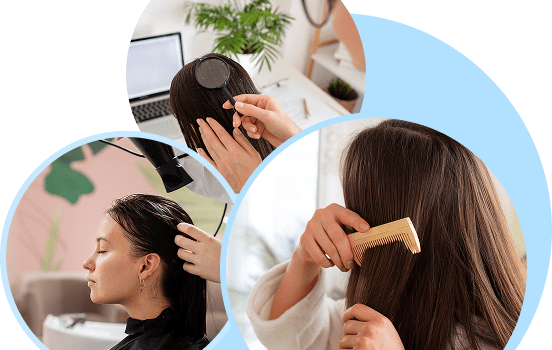
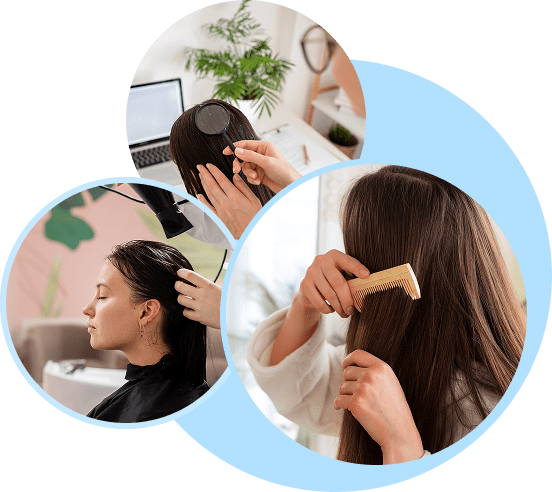
Frequently Asked Questions
We have put some commonly asked questions.
Nunc scelerisque tincidunt elit. Vestibulum non mi ipsum. Cras pretium suscipit tellus sit amet aliquet. Vestibulum maximus lacinia massa nontor.
Platelet-rich plasma (PRP) treatment involves drawing blood from the patient, isolating the beneficial nutrients and injecting it into the scalp where hair loss is occurring. This promotes hair growth and has many other applications from encouraging healing to skin rejuvenation.
Platelet-rich plasma (PRP) treatment involves drawing blood from the patient, isolating the beneficial nutrients and injecting it into the scalp where hair loss is occurring. This promotes hair growth and has many other applications from encouraging healing to skin rejuvenation.
Platelet-rich plasma (PRP) treatment involves drawing blood from the patient, isolating the beneficial nutrients and injecting it into the scalp where hair loss is occurring. This promotes hair growth and has many other applications from encouraging healing to skin rejuvenation.

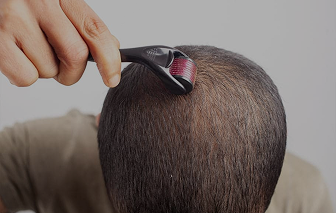

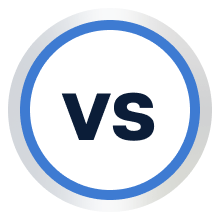

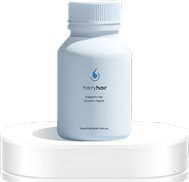
 See All
See All